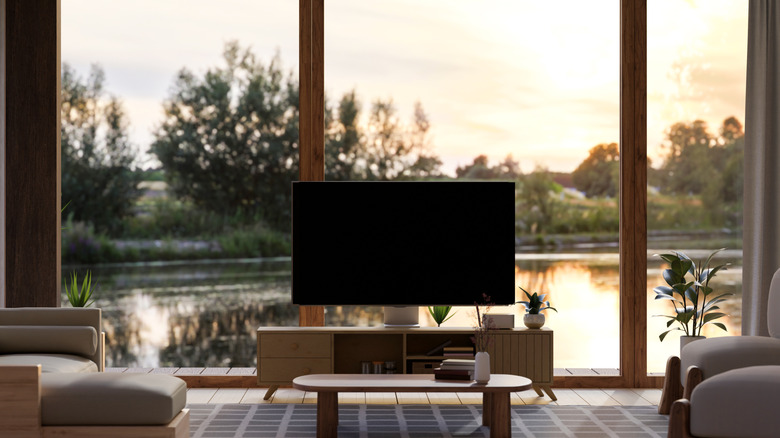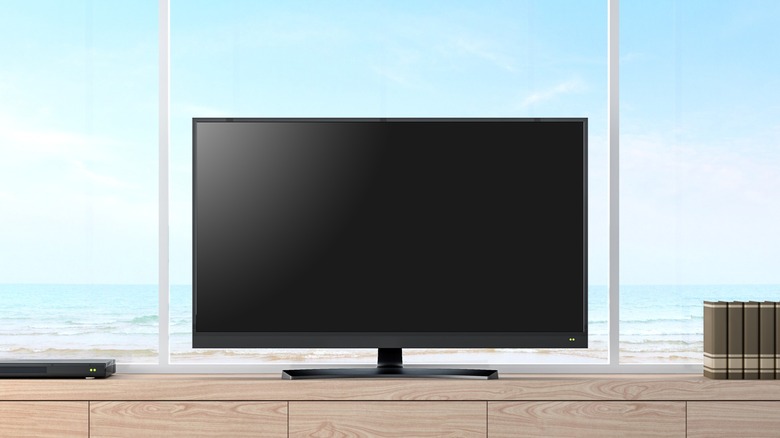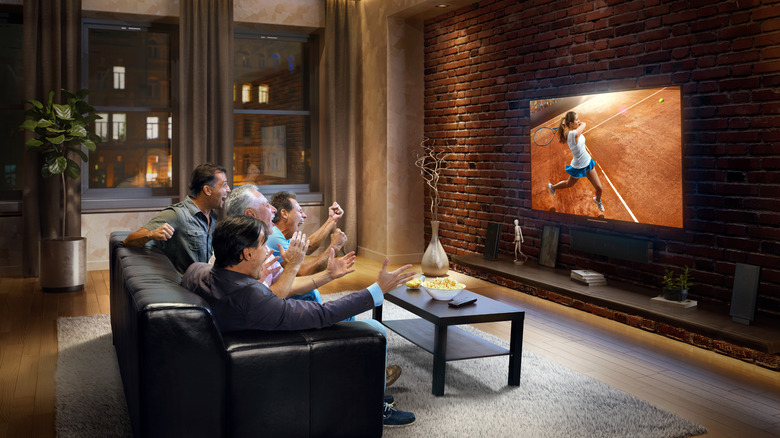Should You Put A TV In Front Of A Window?
Is there anything worse than sitting down in front of the TV to relax with your favorite show or movie, only to be faced with screen glare that prevents you from seeing anything? Well, sure, but it's still frustrating. Too much natural light can ruin the TV-watching experience, so positioning your screen to reduce the glare as much as possible is crucial. And unless you put your TV in a basement, or have the time and money to create a dedicated home theater with perfect viewing conditions, you'll probably have to settle for positioning your TV as best you can.
So, where is the best place to put your TV in a room with a window? Right in front of it? Across from it? Off to the side? To figure this out, it's important to consider how both light and the human eye work. Crucially, light rays bend around objects, including your TV. Rather than blocking glare from your window, light will simply curve around it and go straight into your eyes. That light will often be brighter than the light from your TV, and since the human eye doesn't have HDR, the contrast between the bright window and the relatively dim TV means you won't see the TV as well. Meanwhile, when the screen is angled toward the window, light from the window will bounce off the TV and into your eye. Again, this makes it harder to see the image, even if you have a TV from one of the most reliable brands. So, where should you put your TV to ensure that the windows in your room don't mess with your ability to see the display clearly? Here's what you need to know.
Putting a TV in front of a window is a bad idea
If you're dealing with a room that has four walls and windows on only one side, your best bet will usually be to position the TV on one of the walls to either side of the window. You might be tempted to place the TV right in front of the window so that the light of the window and TV are shining in the same direction. However, this will make the TV harder to see. As noted above, the light from the window will often create too much contrast with the dimmer TV light,
You should also not place a TV with the screen facing the window. This is actually worse than placing it with the screen facing the same direction as the window, because the light from the window will shine directly onto the TV, causing awful glare. You'll see your room reflected in the TV instead of what's on screen.
If, due to the constraints of your space, you must place your TV facing directly toward or away from a window, you can mitigate glare by blocking light from the window. Blackout drapes or something similar are a great option. As long as you can ensure that the TV is brighter than the light behind it, you'll have an easier time seeing what's on screen, though it may still not be an ideal viewing scenario.
Where you should actually put your TV, and why bias lighting is good
Ideally, any light source in the room, whether from a window or light fixture, should shine at the most oblique possible angle to the TV. In a room with three or four walls, that means the TV should go on the wall next to the one with the window, which will usually means the TV ends up at a 90-degree angle to the window. Overhead lights are fine, but turn them off when watching TV. Try not to place any lamps directly in the TV's line of sight. If possible, lamps should be off to the side of the room outside your field of view.
At the same time, some light directly behind your TV can actually help reduce eye strain during long viewing sessions. This is called bias lighting. When you're looking at a bright, concentrated source of light such as your TV against a darker backdrop, it can quickly cause eye strain and fatigue. Think of the times when, during a long session of watching TV, your eyes begin to burn. Adding a small amount of LED light or natural light behind your screen can reduce this strain, but windows are a bad source of bias lighting because the intensity and color of the light will change over the course of the day, while at night, you'll have none. Once your TV is positioned optimally within the room, there's probably more you can do to get the best experience. You can find more tips in our guide on how to optimize your TV for movie viewing.


